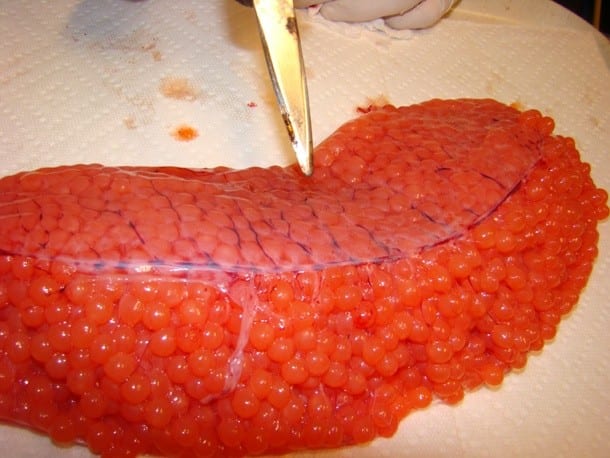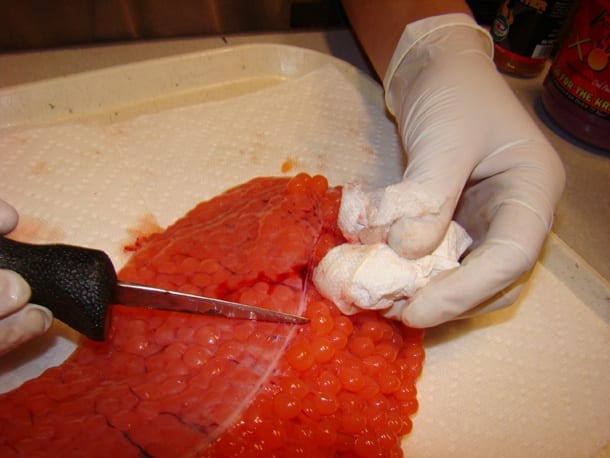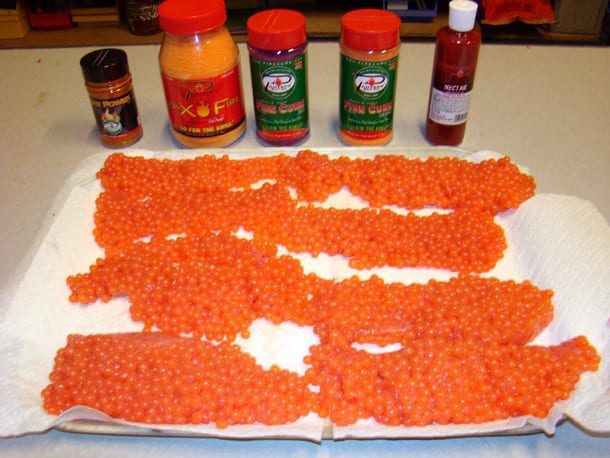Spawn
Learning to Prepare Salmon Eggs For Steelhead Fishing
By Paul LeFebvre | 12/18/2013
By mid to late November in the Pacific Northwest many anglers shift their attention from salmon to steelhead. If you have been successful and caught a few females then good egg preparation will be one key to success in catching winter steelhead.
Many articles and blogs have been written on various techniques for curing salmon eggs. Some are tried and true, like Andy Martin’s Steelhead Candy blog. https://pautzke.com/fireblog_read.php?read=34
If you read through the various Fire Blogs on our website you’ll notice curing techniques vary by region. People approach curing eggs differently. The process becomes personal based on what works for an individual angler. However, these recipes have two things in common: the use of Pautzke’s products and they catch fish!
(Above) Joey LeFebvre releases a 38” x 23 “ winter run steelhead caught on Pautzke’s cures detailed in this blog.
Whether you are using Andy Martin’s Steelhead Candy cure, or another cure on our blog page, it’s important to know that much like good smoked salmon begins with quality salmon, quality cured eggs begins with quality eggs.
It’s fairly common knowledge that upon landing a fresh female fish good practice is to bleed the fish as quickly as possible. However, when the heart of the fish stops abruptly, or time has gone by before bleeding the fish, residual blood can be left in the skein. It’s not uncommon to have some level of blood left in a skein.
(Above) Fresh salmon eggs from a fish that was bled immediately upon landing. Note the small amount of residual blood in the skein.
Joey and I have found a good method for removing this residual blood. We start by laying the eggs on a paper towel and using surgical gloves at all times. If we closely examine the skein shown above, we notice that the many small veins containing blood connect to a single large vein running the full length of the skein.
Now gently use an Oyster knife and push the blood from the smaller veins into the larger vein using a small amount of pressure. The blood will move easily through the vein if you start as shown above and work down the length of the small vein.
(Above) Working the blood out of a fresh skein of eggs.
Next, with a fresh paper towel in hand, push the blood down the large vein and absorb it with the towel until all blood is removed. You will have to do both sides of the skein and, depending on how much blood, you may have to run down some veins twice. It will not take long to accomplish this once you get the hang of it.
When we have completed all blood removal we trim the excess skein.
(Above) Cut and remove the excess skein using a sharp pair of scissors.
The last step before curing is to butterfly the skeins and lay them out onto fresh paper towels.
(Above) A batch of eggs prepared and ready to receive Pautzke’s selection of cures.
Every batch of eggs we work with is taken to this step in the curing process. From here we have a variety of approaches we use to cure the eggs based on the fishery we are preparing for. For example, if we are fishing for salmon we like to use wet cures like Fire Cure. We sprinkle the Fire Cure between the leaves of exposed eggs and allow setting of an hour before placing the eggs in quart jars. Joey and I prefer Pink as a color or Pink and Orange mixtures which result is a snappy cerise like color that is very attractive to fish.
(Above) Joey spreads the individual layers of eggs and sprinkles Orange Fire Cure between the separated rows of eggs.
Additionally we often sprinkle Fire Power (krill powder) onto the cured eggs prior to putting them into jars for the curing process. We use quart jars to put up our wet cured eggs as they can serve as a way of rolling the eggs and dispersing the entire cure uniformly throughout the skeins. We roll the jar every hour or whenever we get a chance for the first two days and then refrigerate.
(Above) Joey is rolling a jar of Orange Fire Cured Eggs during the curing process.
(Above) Jarred eggs setting up from the curing process.
Part of the eggs we put up from salmon season are frozen for future use and others are prepared for steelhead fishing.
The above jars were cured with Fire Cure. However, during steelhead season we’ll take two different kings of cures with us, if not up to five differently cured eggs to the river. The above process is effective, but sometimes the steelies want a borax based cure, which is why I always bring some eggs cured in Andy Martin’s Steelhead Candy cure, too.
To accomplish Andy’s recipe we prepare the eggs using a two-part Orange BorX O Fire and one-part sugar mix. This mix is sprinkled on the eggs with a sizable saltshaker. Unlike wet cures, which take a few days to set-up, BorX O Fire based cures are ready to go literally the next morning. We will cut the cured skeins into small dime-size bits and fish them side drifting with a Puffball for floatation.
(Above) Joey LeFebvre holds a nice winter steelhead prior to release caught side drifting “Steelhead Candy”.
Some of our salmon eggs are frozen for future use using a vacuum sealing process. BE CAREFUL. Vacuum sealing must be released before the process collapses the eggs. If you are not familiar with this step, please freeze your eggs before vacuum sealing.
(Above) Some of our eggs are frozen and vac sealed for future use.
Finally, we prepare a fraction of our salmon egg bounty as eggs clusters for bank fishing for steelhead. Using a machine (shown) we prepare small cut baits inside orange Moline with a Puffball included.
(Above) Joey working the “Bagged Bait” process used in fishing from the bank for steelhead. Note the finished baits near the foreground are no more than the size of a dime.
(Above) A steelhead explodes on the surface of the water after taking ”bagged” bait cured in accordance with the methods described in this blog.
The last aspect of curing and preparing the bait we have from salmon season involves a topic called “color contrast”. Steelhead are sight feeders, so contrast is important. We’ll have to detail that subject in a future blog. As I write this Joey is home from college and on the river fishing for steelhead. I can’t write anymore as he reported he was one for four so far today. You can only guess what I am doing tomorrow.
Tight Lines from the Southern Oregon Coastline!



















